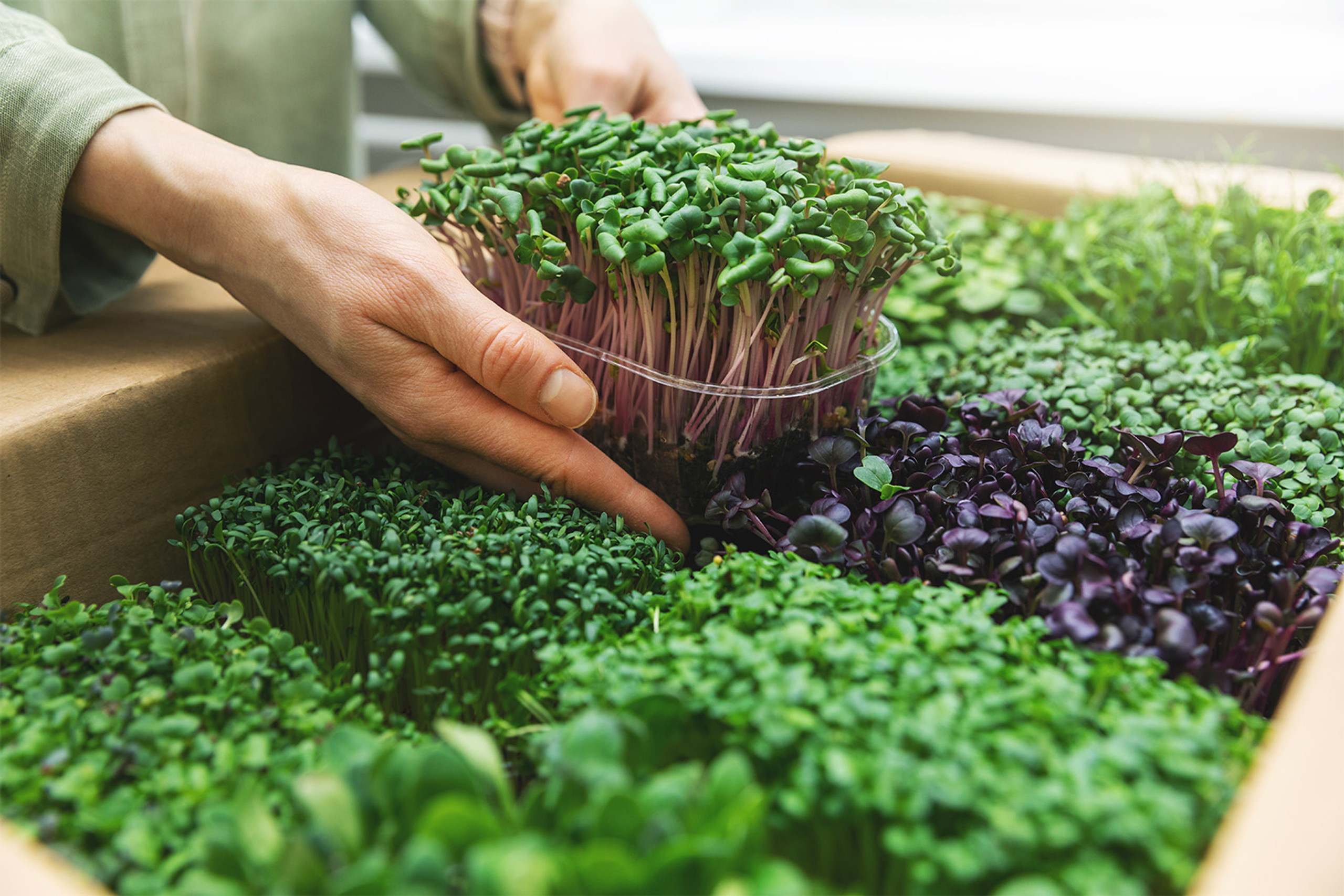Although microgreens have been around for decades, they recently became more popular with the foodie crowd. Microgreens are vegetables that are still early in their growth stages and are extremely nutritious. You can place them in a salad, add them to your juice or smoothies, and so much more.
The real question is: which vegetables are microgreens? Why should you eat them over standard greens? What are the nutritional benefits of microgreens? Read on to learn more about this new healthfood phenomenon.
What Are Microgreens?
Essentially, microgreens are vegetables that haven’t fully matured yet. They are usually harvested a week after the cotyledon (the first leaves that burst from inside the seed) have developed. This gives them an intense flavor and high nutrient content that sets them apart from mature vegetables.
They’re small, hence the “micro” in their name, yet they are completely edible and often taste like their full-size counterparts. In some cases, they are the young, edible leaves from a root vegetable that hasn’t fully developed. They’re often added to soups, salads, and other dishes for an extra nutritional punch.
There are only a small number of vegetables that are eaten in the microgreen form:
- Beet Leaves: The leaves of an immature beet (a root vegetable) are harvested and eaten alongside other microgreens.
- Radishes: Although radish leaves can be removed from the still-growing vegetable and eaten, immature radishes can also be included in the microgreens category. One of the most nutrient-dense is the daikon radish.
- Celery: An immature celery plant, with plenty of leaves at the top of the stalks, is very tender and tastes just like the mature plant.
- Parsley: This herb is full of nutritional value, especially when it’s eaten in microgreen form, as the tender leaves contain plenty of vitamins and minerals.
- Cilantro: Few things are as tasty as this pungent green herb, particularly when you eat it in its immature form.
- Mustard: The small, green leaves of the mustard plant have a unique flavor that makes this microgreen a delicious addition to any meal.
- Cabbage: Although any type of immature cabbage can be eaten as a microgreen, red cabbage microgreens, in particular, are full of vitamin C.
A few other different varieties of microgreens are out there, including arugula, amaranth, watercress, Swiss chard, and broccoli microgreens. Each of these has high concentrations of vitamins and antioxidants, making them certifiable superfoods.
How Big Are These Microgreens?
Although microgreens can vary in size, they do indeed live up to their names. These vegetables are usually between one and three inches tall. They have a stem or stalk, as well as their first set of leaves. They are usually bigger than sprouts and smaller than baby greens.
Microgreens Are Not Sprouts
It’s easy to confuse microgreens with sprouts because both foods are eaten when the plants are still in their immature form.
However, the two are very different. For one thing, sprouts come from beans. The seeds are started in water, and once the tiny shoots emerge, they are ready to eat. These shoots are ready to eat about a week after the seeds are placed in water, and the seeds can be eaten as well.
Microgreens, on the other hand, are between one and three weeks old when they’re harvested and eaten. These greens include the stem and first set of leaves, called the true leaves, of the plant. In addition, microgreens are made of a number of different types of plants, ranging from root vegetables to herbs, not beans.
One characteristic that sprouts and microgreens have in common is the fact that they’re delicious. Both are also quite tasty and can be eaten in many of the same ways, including on sandwiches, in salads, and more.
What About Baby Greens?
The different types of microgreens and baby greens have a lot in common. Both have the green, leafy parts of the plant and the edible stems or stalks. However, the size is where the difference lies. Yes, baby greens are the immature forms of vegetables like lettuce and cabbage, but they are bigger and have been allowed to grow for a longer period of time than microgreens.
Microgreens are smaller and, some say, even more tender than baby greens. Both are tasty and have numerous nutritional benefits, although microgreens have only been allowed to grow for between one and three weeks. They are harvested when their first true leaves form. This isn’t the case with baby greens, which are smaller than their fully grown counterparts but look more like them, with additional leaves and longer edible stems.
What Are the Health Benefits of Microgreens?
Microgreens are more than just the smaller versions of vegetables that you likely eat every day; they’re also better for you. Studies have shown that microgreens contain the same vitamins and minerals as their larger counterparts, but in higher concentrations. In fact, most contain nine times the vitamins and minerals that full-size vegetables have. This means that even one small serving of microgreens is incredibly good for you.
What else can you find in microgreens?
- Polyphenols: Polyphenols and antioxidants tend to overlap, but the former are so good for you that they deserve their own category. Want to improve your digestive system? Want to improve your brain health? Prevent heart disease and diabetes? The answer to all of these questions lies in polyphenols, which are found in microgreens.
- Vitamins: A well-balanced diet contains numerous vitamins, such as vitamins A, B, B12, C, D, E, and more. Where can you find many of these? The answer is in microgreens. These immature plants are packed with all of the vitamins that you need to eat each day. Whether you prefer young celery shoots or tiny cilantro plants, both have all of the health benefits of these vitamins.
- Minerals: Need to raise your overall mineral consumption? Instead of reaching for a multivitamin, go for some microgreens instead. Copper, zinc, calcium, magnesium, potassium, and iron are just a few of the many minerals that you can find in microgreens.
- Antioxidants: These health wonders slow the aging process at a cellular level (yes, that sounds like an infomercial, but it’s true). Antioxidants can make you feel better and younger at the same time. The most common antioxidants are beta-carotene, carotenoids, vitamin C, and vitamin E, all of which are found in microgreens. Others, like manganese and selenium, appear on the list of minerals as well.
How To Eat Microgreens
Thinking about adding microgreens to your next lunch? Here are some meal suggestions. As you can see, microgreens are quite versatile! You can get them from the grocery store or farmers market — or grow your own microgreens on your windowsill.
- Salads: There’s nothing quite like a salad topped with microgreens. They add quite a bit of flavor to your usual blend of lettuce, spinach, carrots, cucumber, and other veggies. You could even make an entire salad out of microgreens, though you’d need a lot of them. It can be much easier to add them to your salad mix.
- Meal Toppings: If you want to serve your meals with an extra side of nutrition and tastiness, then look no further than microgreens. You can put them on top of steak, serve them alongside grilled fish or chicken, and even sprinkle some of them on pasta.
- Sandwiches: Enjoy eating lettuce on your sandwiches? Try switching it out for microgreens. Not only will they add some extra flavor, but they have additional nutritious benefits that many basic forms of lettuce don’t have. Looking for a suggestion? Try microgreens made from celery, cilantro, or parsley.
- Garnishes: Want to add a lovely (and tasty) garnish to your homemade hummus? Think that your spinach and avocado dip is missing something? The solution to both of these lies in microgreens. Simply sprinkle a bit of beet or radish microgreens on top of your dip before serving, and watch the delight of your guests when they find out how much better everything tastes.
- Smoothies and Juice: Do you make your own juices or smoothies in the morning? While you’re compiling all of your ingredients in the mixer or juicer, consider adding some microgreens as well. They’re small and tender, so they blend up easily, and they’ll add some extra nutrition to your morning drink.
Microgreens Are Healthy and Tasty
Microgreens are more than just the latest food trend. They’re a great addition to just about any meal. You can put them in your salad, toss them on your steak or grilled fish, and even place them on top of your sandwiches. No matter how you choose to eat your microgreens, you’re getting all of their nutritious benefits.
If you want to add microgreens to your daily diet, but aren’t quite sure how to do so, contact MyFitFoods. We’ll give you plenty of advice and even suggest a few of our meals that you can add microgreens to.
Sources:
Microgreens: All You Ever Wanted to Know | Healthline
The Science Behind Microgreens as an Exciting New Food for the 21st Century | NCBI
About Author: Mario Mendias





